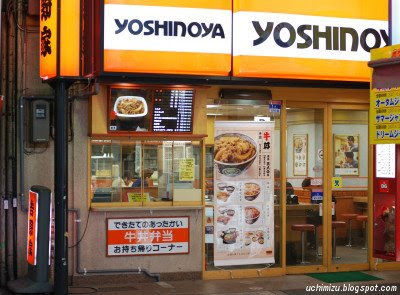During the economic bubble of the eighties, Japan was the costliest country in the world. Surfing on the upswing mood, companies sold their ware as expensive as possible, playing on brands and fashion. Ten years of economic stagnation followed, with many of them having to struggle for survival. Most reduced their expenditure to the minimum in order to lower prices. Not everything became cheap. Housing is still expensive, and, as it loses most of its value after a few decades, is not an investment. The motorways are very expensive, sometimes twice or thrice the price of already costly French or Italian motorways. However, many goods and services are now offered at a price far lower than in Europe, with far superior service standards.
This story takes as an illustration half a day in the Kansai (関西) area. It regroups in less than 100 kilometers the economic powerhouse of Osaka (大阪), the fashionable port of Kobe (神戸), and the major tourist attractions of Kyoto (京都) and Nara (奈良). This is not countryside, but a region that compares well with Paris, Amsterdam, or Hamburg in population and wealth.
Our day started, quite predictably, in a hotel. We booked a double room in a western style “business hotel” located downtown Osaka. The accommodation was quite new, and perfectly clean. The room was not so large, but included free high-speed Internet, a shaving kit, a toothbrush, and a cotton yukata for the evening. A buffet style breakfast was served in hotel lobby in the morning. The price for a night is around Y8700 (54 Euros) for an advance internet reservation. As a comparison, a room in the central Ibis Hotel in downtown Bristol will set you back £56 (90 Euros). This price does not include internet connection, the shaving kit, and breakfast is extra.
We then left for shopping in downtown Osaka. As my glasses were worn out, I went to the “Alook” shop. Having chosen the frame, the attendant proposed to perform an eye test, or to use lenses identical to my current glasses. After a quick try, the frames left for the workshop, and were ready one hour later. The price of this very efficient service is Y5050 (around 31.5 Euros) for classical organic glasses. The cheaper French glasses shops do not go under 39 Euros.

After shopping, we left for Kyoto. The Keihan (京阪) company has a “limited express” service running on the 50km tracks links the downtown area of both cities. The seats can be oriented in the direction the train is running, and all coaches have air conditioning. The train is always running on time, with an excellent service: there are employees at most stations, and a conductor is on board of the train in addition to the driver. The fare is Y460 (2.80 Euros). In comparison, the very decent Transpennine service between York and Leeds (42 km) is around £9.20 (12 Euro) for a full fare ticket.

In Kyoto, we were in the mood for Tofu, and we headed for the sosoan (爽草庵) restaurant, close to the silver pavilion (銀閣寺), a major tourist spot. A very refined lunch is served every day: starters included a grilled trout fillet, Japanese omelets and a delicious steamed bun. The main dish was a pot of Tofu (豆腐), served with rice and miso soup. The menu also included dessert: a white wine jelly with strawberries. The atmosphere of the restaurant was peaceful, and the service was fast and elegant. As in most places in Japan, guests are welcome with a glass of fresh water and a hot towel, and excellent tea is served at no cost during the whole meal. The menu price is 2500 Yens (15.6 Euros). A decent meal in a parisian « brasserie » will set you back at least 25 Euros.

The examples highlighted here are not the most extreme. We could have spoken about the numerous healthy and cheap fast-food joints, such as the Otoya (大戸屋) chain, with grilled fish menu served in very decent restaurants for around Y700. Yoshinoya (吉野家) is even cheaper, at Y400 for a rice bowl with sliced meat on top. We did not speak here about high tech stuff, such as cameras, often far cheaper in Japan.
Those low prices have many reasons. VAT is only 5% in Japan, and social contributions are far lower than in Europe, especially for student or temporary workers. Competition is often more intense in Japan than in Europe: there are 4 different companies (Keihan, JR, Kintetsu et Hankyu) offering train service between Osaka and Kyoto. This does not explain everything, and one can wonder if France or England would need a few years of recession to get back in touch with reality.
Note : this article does not want to shame European companies chosen here, most of them being amongst the more competitive of their industry, and with very different constraints from their Japanese colleagues.
Sosoan 爽草庵 京都市左京区浄土寺下南田町129shimominamidacho jodoji sakyo-ku Tel : 0757713617. Close to Ginkakuji (銀閣寺), and 20 minutes walk from Demachiyanagi (出町柳) station.









